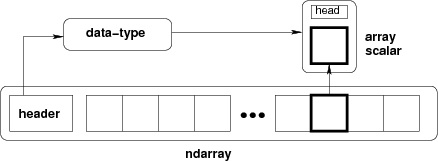NumPy - Ndarray Object
The most important object defined in NumPy is an N-dimensional array type called ndarray. It describes the collection of items of the same type. Items in the collection can be accessed using a zero-based index.
Every item in an ndarray takes the same size of block in the memory. Each element in ndarray is an object of data-type object (called dtype).
Any item extracted from ndarray object (by slicing) is represented by a Python object of one of array scalar types. The following diagram shows a relationship between ndarray, data type object (dtype) and array scalar type −

An instance of ndarray class can be constructed by different array creation routines described later in the tutorial. The basic ndarray is created using an array function in NumPy as follows −
numpy.array
It creates an ndarray from any object exposing array interface, or from any method that returns an array.
numpy.array(object, dtype = None, copy = True, order = None, subok = False, ndmin = 0)
The above constructor takes the following parameters −
| Sr.No. | Parameter & Description |
|---|---|
| 1 |
object
Any object exposing the array interface method returns an array, or any (nested) sequence.
|
| 2 |
dtype
Desired data type of array, optional
|
| 3 |
copy
Optional. By default (true), the object is copied
|
| 4 |
order
C (row major) or F (column major) or A (any) (default)
|
| 5 |
subok
By default, returned array forced to be a base class array. If true, sub-classes passed through
|
| 6 |
ndmin
Specifies minimum dimensions of resultant array
|
Take a look at the following examples to understand better.
Example 1
Live Demoimport numpy as np a = np.array([1,2,3]) print a
The output is as follows −
[1, 2, 3]
Example 2
Live Demo# more than one dimensions import numpy as np a = np.array([[1, 2], [3, 4]]) print a
The output is as follows −
[[1, 2] [3, 4]]
Example 3
Live Demo# minimum dimensions import numpy as np a = np.array([1, 2, 3,4,5], ndmin = 2) print a
The output is as follows −
[[1, 2, 3, 4, 5]]
Example 4
Live Demo# dtype parameter import numpy as np a = np.array([1, 2, 3], dtype = complex) print a
The output is as follows −
[ 1.+0.j, 2.+0.j, 3.+0.j]
The ndarray object consists of contiguous one-dimensional segment of computer memory, combined with an indexing scheme that maps each item to a location in the memory block. The memory block holds the elements in a row-major order (C style) or a column-major order (FORTRAN or MatLab style).
Hello Admin,
ReplyDeleteThe most significant article characterized in NumPy is an N-dimensional exhibit type called ndarray. It depicts the assortment of things of a similar sort. Things in the assortment can be gotten to utilizing a zero-based record.
Each thing in a ndarray takes a similar size of the square in the memory. Every component in ndarray is an object of information type object (called type).
Regards,
Thanks
RITU